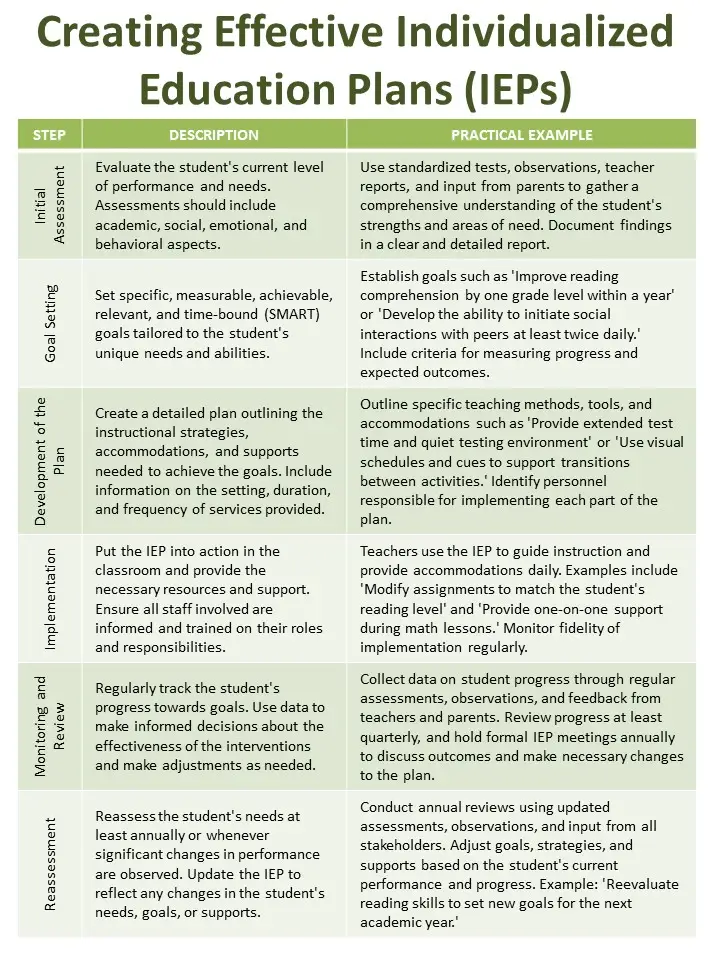Individualized Education Plans (IEPs) play a crucial role in ensuring that students with special needs receive the tailored support they need to succeed both academically and socially. This article explores the key steps in creating effective IEPs, highlighting practical examples, best practices for optimizing the process, and includes a Q&A section to address common concerns.
1. Initial Assessment
Description: The initial assessment forms the foundation of an effective IEP. It involves evaluating the student’s current level of performance and needs across various domains, including academic, social, emotional, and behavioral aspects.
Practical Example: Utilize standardized tests, observations, teacher reports, and input from parents to gather a comprehensive understanding of the student’s strengths and areas of need. Document findings in a clear and detailed report.
Best Practices:
- Involve a multidisciplinary team for a comprehensive assessment.
- Use a variety of tools and assessment methods to get an accurate picture.
- Ensure parents understand the assessment process and its objectives.
2. Goal Setting
Description: Set specific, measurable, achievable, relevant, and time-bound (SMART) goals tailored to the student’s unique needs and abilities.
Practical Example: Establish goals such as “Improve reading comprehension by one grade level within a year” or “Develop the ability to initiate social interactions with peers at least twice daily.” Include criteria for measuring progress and expected outcomes.
Best Practices:
- Involve the student in setting their goals when possible.
- Use interim goals to track progress towards long-term objectives.
- Regularly review and adjust goals based on the student’s progress.
3. Development of the Plan
Description: Create a detailed plan outlining the instructional strategies, accommodations, and supports needed to achieve the goals. Include information on the setting, duration, and frequency of services provided.
Practical Example: Outline specific teaching methods, tools, and accommodations such as “Provide extended test time and a quiet testing environment” or “Use visual cues and prompts to support transitions between activities.” Identify personnel responsible for implementing each part of the plan.
Best Practices:
- Ensure clear and regular communication among all team members.
- Tailor teaching strategies to the student’s individual learning styles.
- Document all interventions and adjustments made.
4. Implementation
Description: Put the IEP into action in the classroom and provide the necessary resources and support. Ensure all staff involved are informed and trained on their roles and responsibilities.
Practical Example: Teachers use the IEP to guide instruction and provide daily accommodations. Examples include “Modify assignments to match the student’s reading level” and “Provide one-on-one support during math lessons.” Monitor implementation fidelity regularly.
Best Practices:
- Provide ongoing training for staff to stay updated on best practices.
- Use tracking tools to measure the fidelity of intervention implementation.
- Engage parents and students in the implementation process.
5. Monitoring and Review
Description: Regularly track the student’s progress towards goals. Use data to make informed decisions about the effectiveness of the interventions and make necessary adjustments.
Practical Example: Collect data on student progress through regular assessments, observations, and feedback from teachers and parents. Review progress at least quarterly and hold formal IEP meetings annually to discuss outcomes and make necessary changes to the plan.
Best Practices:
- Use data tracking tools for regular progress analysis.
- Hold frequent review meetings to adjust the plan as needed.
- Communicate regularly with parents and students about progress and adjustments.
6. Reassessment
Description: Reassess the student’s needs at least annually or whenever significant changes in performance are observed. Update the IEP to reflect any changes in the student’s needs, goals, or supports.
Practical Example: Conduct annual reviews using updated assessments, observations, and input from all stakeholders. Adjust goals, strategies, and supports based on the student’s current performance and progress. Example: “Reevaluate reading skills to set new goals for the next academic year.”
Best Practices:
- Involve all stakeholders in the reassessment process.
- Use updated assessments and data to inform decisions.
- Be flexible and ready to adjust the plan based on the student’s changing needs.
Questions and Answers
Q: What are the key components of a successful IEP? A: A successful IEP includes an accurate initial assessment, clearly defined SMART goals, a detailed implementation plan, regular monitoring and review, and annual or as-needed reassessment.
Q: How can parents be involved in the IEP process? A: Parents can be involved by participating in IEP meetings, providing input about their child’s strengths and needs, and collaborating with teachers to support IEP implementation at home.
Q: What are common challenges in implementing an IEP and how can they be overcome? A: Common challenges include lack of resources, insufficient communication among team members, and the need for adjustments to meet the student’s changing needs. To overcome these challenges, provide continuous training, maintain clear and regular communication, and remain flexible and adaptable.
Q: How can the effectiveness of an IEP be measured? A: The effectiveness of an IEP can be measured by tracking the student’s progress toward the defined goals, analyzing assessment and observation data, and collecting regular feedback from teachers, parents, and the student.
Conclusion
Creating an effective IEP requires continuous collaboration and evaluation. By following these steps and incorporating practical examples, educators can ensure that each student receives the personalized support they need to succeed. Parents, teachers, and other stakeholders must work together to constantly adjust and improve the plan, taking into account the student’s progress and changing needs.







